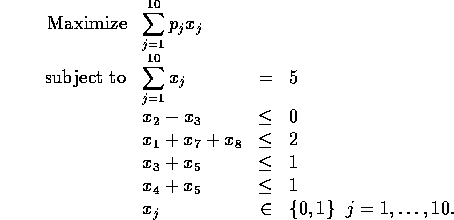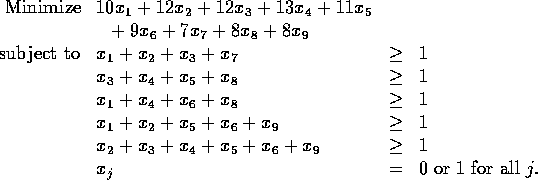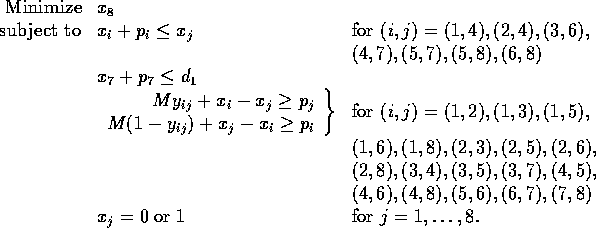
Exercise 1: The formulation is:

Exercise 2: Let ![]() be a 0,1 variable which equals 1 if route
j is used, 0 otherwise. Then the vehicle routing problem can be formulated
as a set covering problem:
be a 0,1 variable which equals 1 if route
j is used, 0 otherwise. Then the vehicle routing problem can be formulated
as a set covering problem:

Exercise 3: Let ![]() starting time of operation j.
starting time of operation j.
![]()
Then the formulation is:

The first set of constraints are the precedence constraints and the last two sets are the noninterference constraints.
Exercise 4: First we solve the problem as a linear program with LINDO.
The solution is ![]() ,
, ![]() . Rounding it yields
. Rounding it yields ![]() ,
,
![]() which fails to satisfy the constraint
which fails to satisfy the constraint ![]() .
.
In fact, the only feasible integer solution is
![]()
and it cannot be obtained by simple rounding.
Exercise 5: The enumeration tree is given in Figure 8.
Three optimum integer solutions were found, namely
![]()
each with value z=5.
Exercise 6
From the enumeration tree of Exercise 5, we see that only one branching is
necessary since both subproblems ![]() and
and ![]() are inactive by reason of
integrality. The better solution is
are inactive by reason of
integrality. The better solution is ![]() with value
with value ![]() .
.
Exercise 7
MAX 4 X1 + 7 X2 + 6 X3 + 5 X4 + 4 X5
SUBJECT TO
2) 5 X1 + 8 X2 + 3 X3 + 2 X4 + 7 X5 <= 112
3) X1 + 8 X2 + 6 X3 + 5 X4 + 4 X5 <= 109
END
GIN 5
ENUMERATION COMPLETE. BRANCHES= 6 PIVOTS= 20
OBJECTIVE FUNCTION VALUE 151.000
VARIABLE VALUE REDUCED COST
X1 14.000 -4.000
X2 .000 -7.000
X3 .000 -6.000
X4 19.000 -5.000
X5 .000 -4.000
Exercise 8
Since ![]() does not satisfy the knapsack constraint
does not satisfy the knapsack constraint
![]() , it follows that
, it follows that ![]() must hold for all solutions of the knapsack problem.
must hold for all solutions of the knapsack problem.
Similarly for ![]() .
.
MAX 8 X1 + 11 X2 + 6 X3 + 4 X4
SUBJECT TO
2) 5 X1 + 7 X2 + 4 X3 + 3 X4 <= 14
3) X1 + X2 + X3 <= 2
3) X1 + X2 + X4 <= 2
END
SUB X1 1
SUB X2 1
SUB X3 1
SUB X4 1
OBJECTIVE FUNCTION VALUE 21.000
VARIABLE VALUE REDUCED COST
X1 .000 0.000
X2 1.000 -3.000
X3 1.000 -2.000
X4 1.000 0.000